Travel and Tourism Report: Destination Analysis and Improvement
VerifiedAdded on 2020/05/28
|8
|1606
|80
Report
AI Summary
This report, prepared for a Travel and Tourism course, analyzes the characteristics of appealing tourist destinations, comparing leading destinations like London with developing ones such as Costa Rica. It examines factors influencing tourist decisions, including business advancement, security, product life cycles, financial stability, and political issues. The report further evaluates key issues affecting destination popularity, such as legislation, security concerns (including terrorist attacks), climatic conditions, economic situations, and exchange rates. Finally, it discusses the responsibilities of the tourism industry in improving host communities globally, highlighting strategic plans like Scotland's "Visit Scotland" initiative, which focuses on social equality, economic prosperity, and cultural protection. The report references several academic sources to support its findings and analysis.
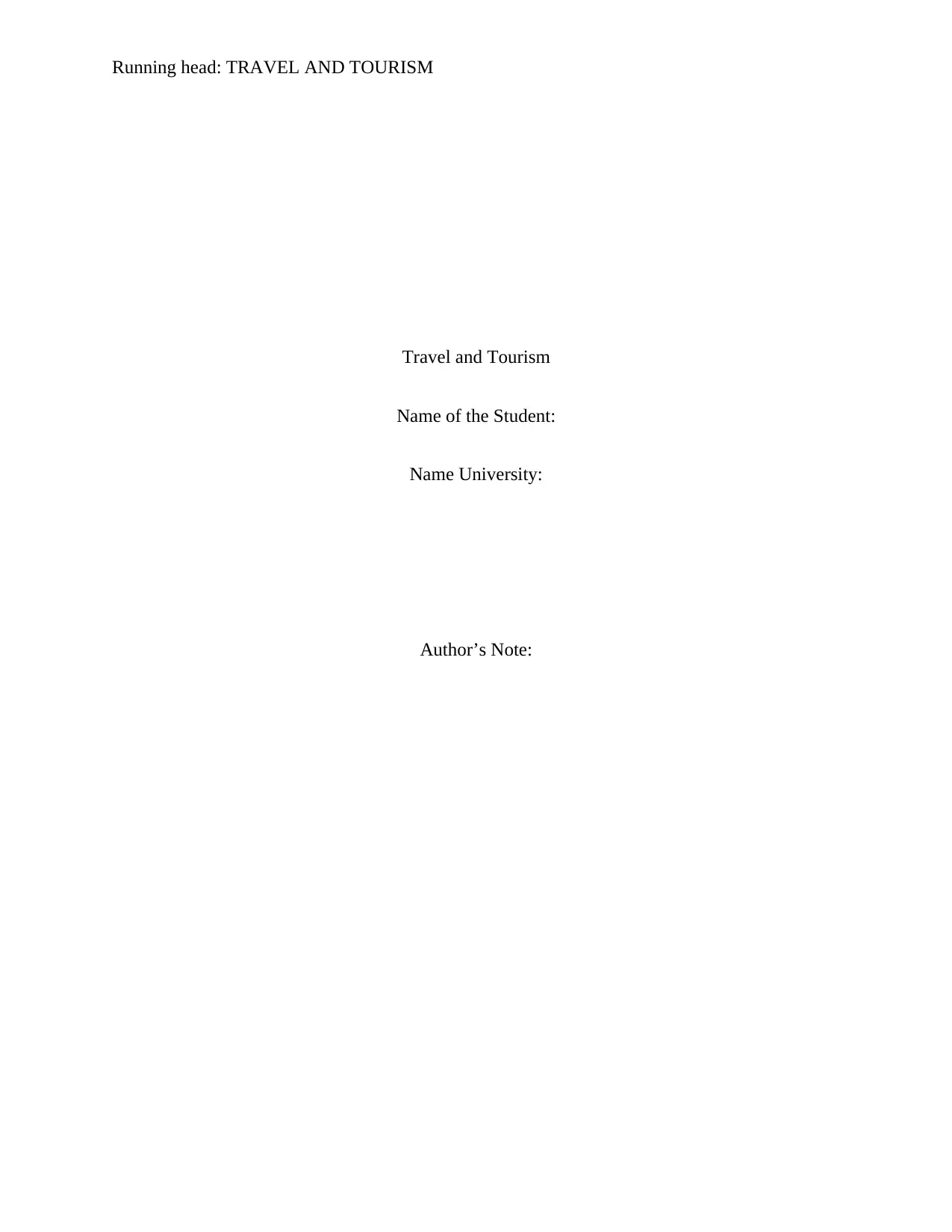
Running head: TRAVEL AND TOURISM
Travel and Tourism
Name of the Student:
Name University:
Author’s Note:
Travel and Tourism
Name of the Student:
Name University:
Author’s Note:
Paraphrase This Document
Need a fresh take? Get an instant paraphrase of this document with our AI Paraphraser
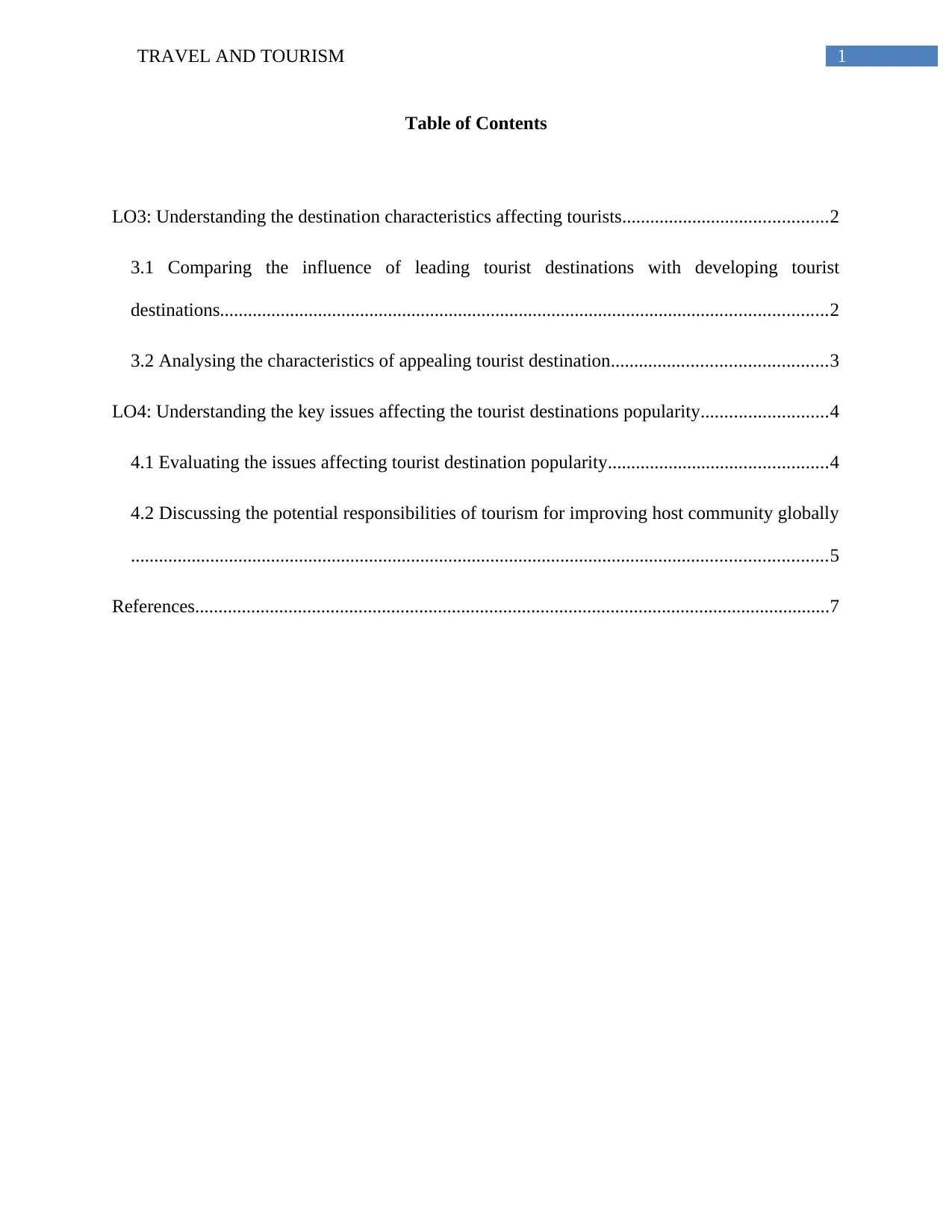
1TRAVEL AND TOURISM
Table of Contents
LO3: Understanding the destination characteristics affecting tourists............................................2
3.1 Comparing the influence of leading tourist destinations with developing tourist
destinations..................................................................................................................................2
3.2 Analysing the characteristics of appealing tourist destination..............................................3
LO4: Understanding the key issues affecting the tourist destinations popularity...........................4
4.1 Evaluating the issues affecting tourist destination popularity...............................................4
4.2 Discussing the potential responsibilities of tourism for improving host community globally
.....................................................................................................................................................5
References........................................................................................................................................7
Table of Contents
LO3: Understanding the destination characteristics affecting tourists............................................2
3.1 Comparing the influence of leading tourist destinations with developing tourist
destinations..................................................................................................................................2
3.2 Analysing the characteristics of appealing tourist destination..............................................3
LO4: Understanding the key issues affecting the tourist destinations popularity...........................4
4.1 Evaluating the issues affecting tourist destination popularity...............................................4
4.2 Discussing the potential responsibilities of tourism for improving host community globally
.....................................................................................................................................................5
References........................................................................................................................................7
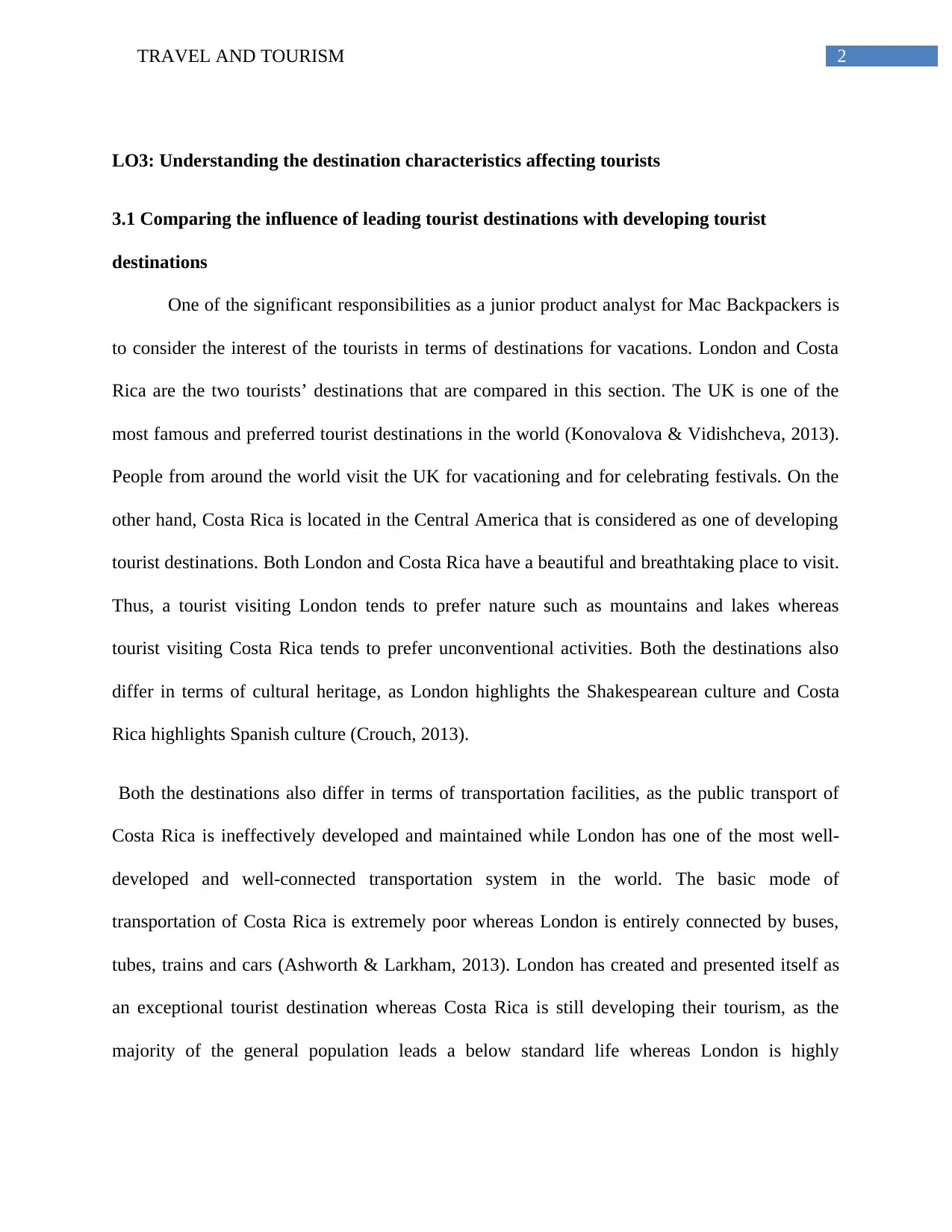
2TRAVEL AND TOURISM
LO3: Understanding the destination characteristics affecting tourists
3.1 Comparing the influence of leading tourist destinations with developing tourist
destinations
One of the significant responsibilities as a junior product analyst for Mac Backpackers is
to consider the interest of the tourists in terms of destinations for vacations. London and Costa
Rica are the two tourists’ destinations that are compared in this section. The UK is one of the
most famous and preferred tourist destinations in the world (Konovalova & Vidishcheva, 2013).
People from around the world visit the UK for vacationing and for celebrating festivals. On the
other hand, Costa Rica is located in the Central America that is considered as one of developing
tourist destinations. Both London and Costa Rica have a beautiful and breathtaking place to visit.
Thus, a tourist visiting London tends to prefer nature such as mountains and lakes whereas
tourist visiting Costa Rica tends to prefer unconventional activities. Both the destinations also
differ in terms of cultural heritage, as London highlights the Shakespearean culture and Costa
Rica highlights Spanish culture (Crouch, 2013).
Both the destinations also differ in terms of transportation facilities, as the public transport of
Costa Rica is ineffectively developed and maintained while London has one of the most well-
developed and well-connected transportation system in the world. The basic mode of
transportation of Costa Rica is extremely poor whereas London is entirely connected by buses,
tubes, trains and cars (Ashworth & Larkham, 2013). London has created and presented itself as
an exceptional tourist destination whereas Costa Rica is still developing their tourism, as the
majority of the general population leads a below standard life whereas London is highly
LO3: Understanding the destination characteristics affecting tourists
3.1 Comparing the influence of leading tourist destinations with developing tourist
destinations
One of the significant responsibilities as a junior product analyst for Mac Backpackers is
to consider the interest of the tourists in terms of destinations for vacations. London and Costa
Rica are the two tourists’ destinations that are compared in this section. The UK is one of the
most famous and preferred tourist destinations in the world (Konovalova & Vidishcheva, 2013).
People from around the world visit the UK for vacationing and for celebrating festivals. On the
other hand, Costa Rica is located in the Central America that is considered as one of developing
tourist destinations. Both London and Costa Rica have a beautiful and breathtaking place to visit.
Thus, a tourist visiting London tends to prefer nature such as mountains and lakes whereas
tourist visiting Costa Rica tends to prefer unconventional activities. Both the destinations also
differ in terms of cultural heritage, as London highlights the Shakespearean culture and Costa
Rica highlights Spanish culture (Crouch, 2013).
Both the destinations also differ in terms of transportation facilities, as the public transport of
Costa Rica is ineffectively developed and maintained while London has one of the most well-
developed and well-connected transportation system in the world. The basic mode of
transportation of Costa Rica is extremely poor whereas London is entirely connected by buses,
tubes, trains and cars (Ashworth & Larkham, 2013). London has created and presented itself as
an exceptional tourist destination whereas Costa Rica is still developing their tourism, as the
majority of the general population leads a below standard life whereas London is highly
⊘ This is a preview!⊘
Do you want full access?
Subscribe today to unlock all pages.

Trusted by 1+ million students worldwide
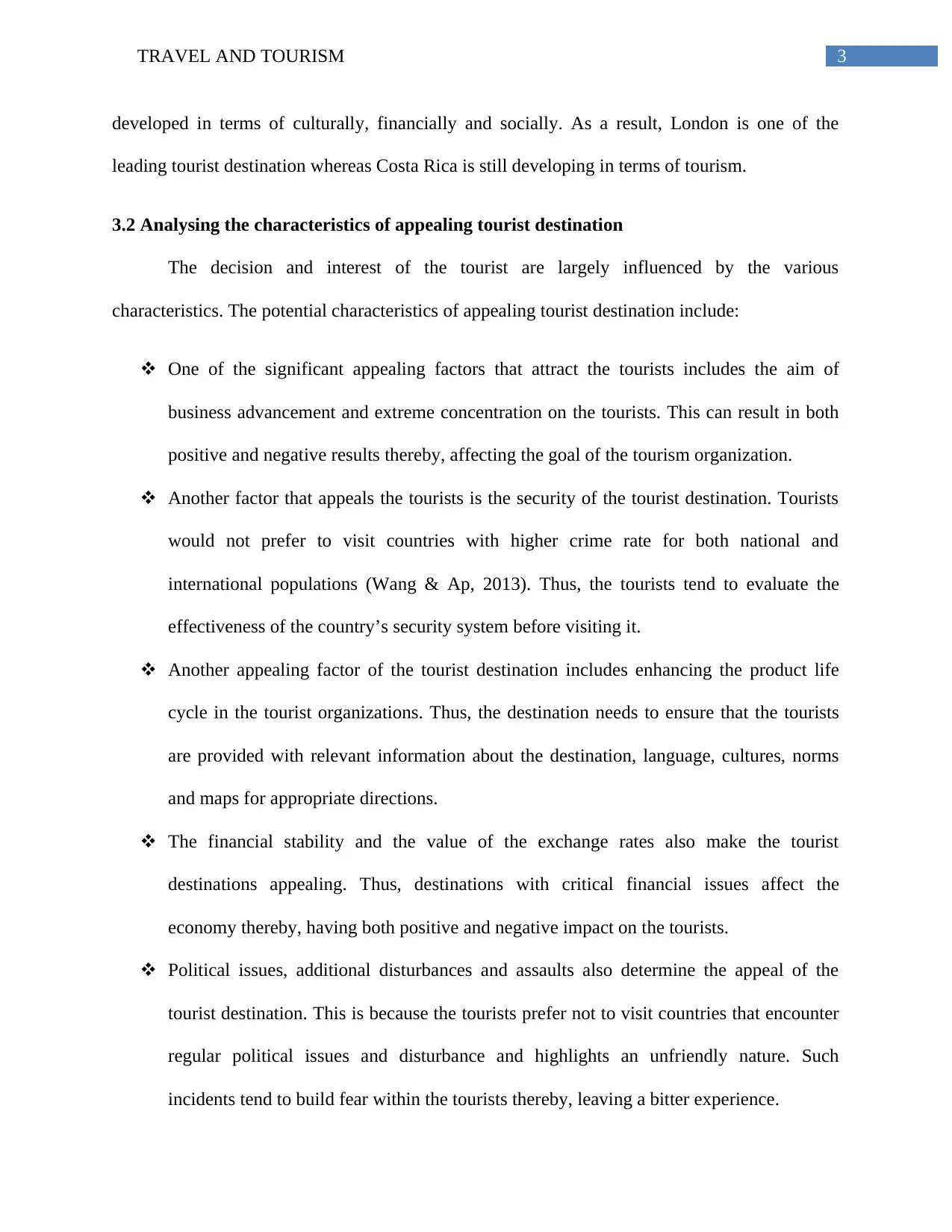
3TRAVEL AND TOURISM
developed in terms of culturally, financially and socially. As a result, London is one of the
leading tourist destination whereas Costa Rica is still developing in terms of tourism.
3.2 Analysing the characteristics of appealing tourist destination
The decision and interest of the tourist are largely influenced by the various
characteristics. The potential characteristics of appealing tourist destination include:
One of the significant appealing factors that attract the tourists includes the aim of
business advancement and extreme concentration on the tourists. This can result in both
positive and negative results thereby, affecting the goal of the tourism organization.
Another factor that appeals the tourists is the security of the tourist destination. Tourists
would not prefer to visit countries with higher crime rate for both national and
international populations (Wang & Ap, 2013). Thus, the tourists tend to evaluate the
effectiveness of the country’s security system before visiting it.
Another appealing factor of the tourist destination includes enhancing the product life
cycle in the tourist organizations. Thus, the destination needs to ensure that the tourists
are provided with relevant information about the destination, language, cultures, norms
and maps for appropriate directions.
The financial stability and the value of the exchange rates also make the tourist
destinations appealing. Thus, destinations with critical financial issues affect the
economy thereby, having both positive and negative impact on the tourists.
Political issues, additional disturbances and assaults also determine the appeal of the
tourist destination. This is because the tourists prefer not to visit countries that encounter
regular political issues and disturbance and highlights an unfriendly nature. Such
incidents tend to build fear within the tourists thereby, leaving a bitter experience.
developed in terms of culturally, financially and socially. As a result, London is one of the
leading tourist destination whereas Costa Rica is still developing in terms of tourism.
3.2 Analysing the characteristics of appealing tourist destination
The decision and interest of the tourist are largely influenced by the various
characteristics. The potential characteristics of appealing tourist destination include:
One of the significant appealing factors that attract the tourists includes the aim of
business advancement and extreme concentration on the tourists. This can result in both
positive and negative results thereby, affecting the goal of the tourism organization.
Another factor that appeals the tourists is the security of the tourist destination. Tourists
would not prefer to visit countries with higher crime rate for both national and
international populations (Wang & Ap, 2013). Thus, the tourists tend to evaluate the
effectiveness of the country’s security system before visiting it.
Another appealing factor of the tourist destination includes enhancing the product life
cycle in the tourist organizations. Thus, the destination needs to ensure that the tourists
are provided with relevant information about the destination, language, cultures, norms
and maps for appropriate directions.
The financial stability and the value of the exchange rates also make the tourist
destinations appealing. Thus, destinations with critical financial issues affect the
economy thereby, having both positive and negative impact on the tourists.
Political issues, additional disturbances and assaults also determine the appeal of the
tourist destination. This is because the tourists prefer not to visit countries that encounter
regular political issues and disturbance and highlights an unfriendly nature. Such
incidents tend to build fear within the tourists thereby, leaving a bitter experience.
Paraphrase This Document
Need a fresh take? Get an instant paraphrase of this document with our AI Paraphraser
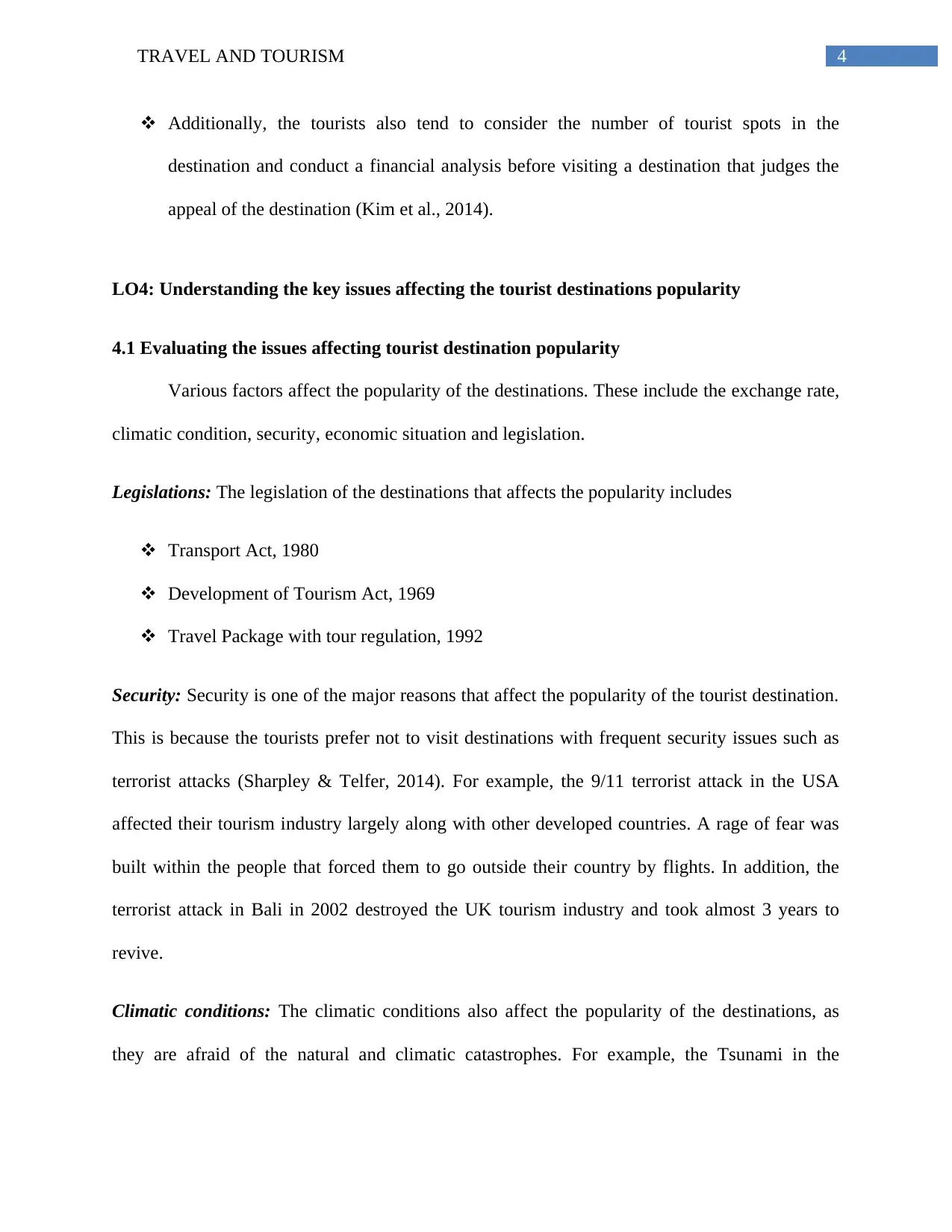
4TRAVEL AND TOURISM
Additionally, the tourists also tend to consider the number of tourist spots in the
destination and conduct a financial analysis before visiting a destination that judges the
appeal of the destination (Kim et al., 2014).
LO4: Understanding the key issues affecting the tourist destinations popularity
4.1 Evaluating the issues affecting tourist destination popularity
Various factors affect the popularity of the destinations. These include the exchange rate,
climatic condition, security, economic situation and legislation.
Legislations: The legislation of the destinations that affects the popularity includes
Transport Act, 1980
Development of Tourism Act, 1969
Travel Package with tour regulation, 1992
Security: Security is one of the major reasons that affect the popularity of the tourist destination.
This is because the tourists prefer not to visit destinations with frequent security issues such as
terrorist attacks (Sharpley & Telfer, 2014). For example, the 9/11 terrorist attack in the USA
affected their tourism industry largely along with other developed countries. A rage of fear was
built within the people that forced them to go outside their country by flights. In addition, the
terrorist attack in Bali in 2002 destroyed the UK tourism industry and took almost 3 years to
revive.
Climatic conditions: The climatic conditions also affect the popularity of the destinations, as
they are afraid of the natural and climatic catastrophes. For example, the Tsunami in the
Additionally, the tourists also tend to consider the number of tourist spots in the
destination and conduct a financial analysis before visiting a destination that judges the
appeal of the destination (Kim et al., 2014).
LO4: Understanding the key issues affecting the tourist destinations popularity
4.1 Evaluating the issues affecting tourist destination popularity
Various factors affect the popularity of the destinations. These include the exchange rate,
climatic condition, security, economic situation and legislation.
Legislations: The legislation of the destinations that affects the popularity includes
Transport Act, 1980
Development of Tourism Act, 1969
Travel Package with tour regulation, 1992
Security: Security is one of the major reasons that affect the popularity of the tourist destination.
This is because the tourists prefer not to visit destinations with frequent security issues such as
terrorist attacks (Sharpley & Telfer, 2014). For example, the 9/11 terrorist attack in the USA
affected their tourism industry largely along with other developed countries. A rage of fear was
built within the people that forced them to go outside their country by flights. In addition, the
terrorist attack in Bali in 2002 destroyed the UK tourism industry and took almost 3 years to
revive.
Climatic conditions: The climatic conditions also affect the popularity of the destinations, as
they are afraid of the natural and climatic catastrophes. For example, the Tsunami in the
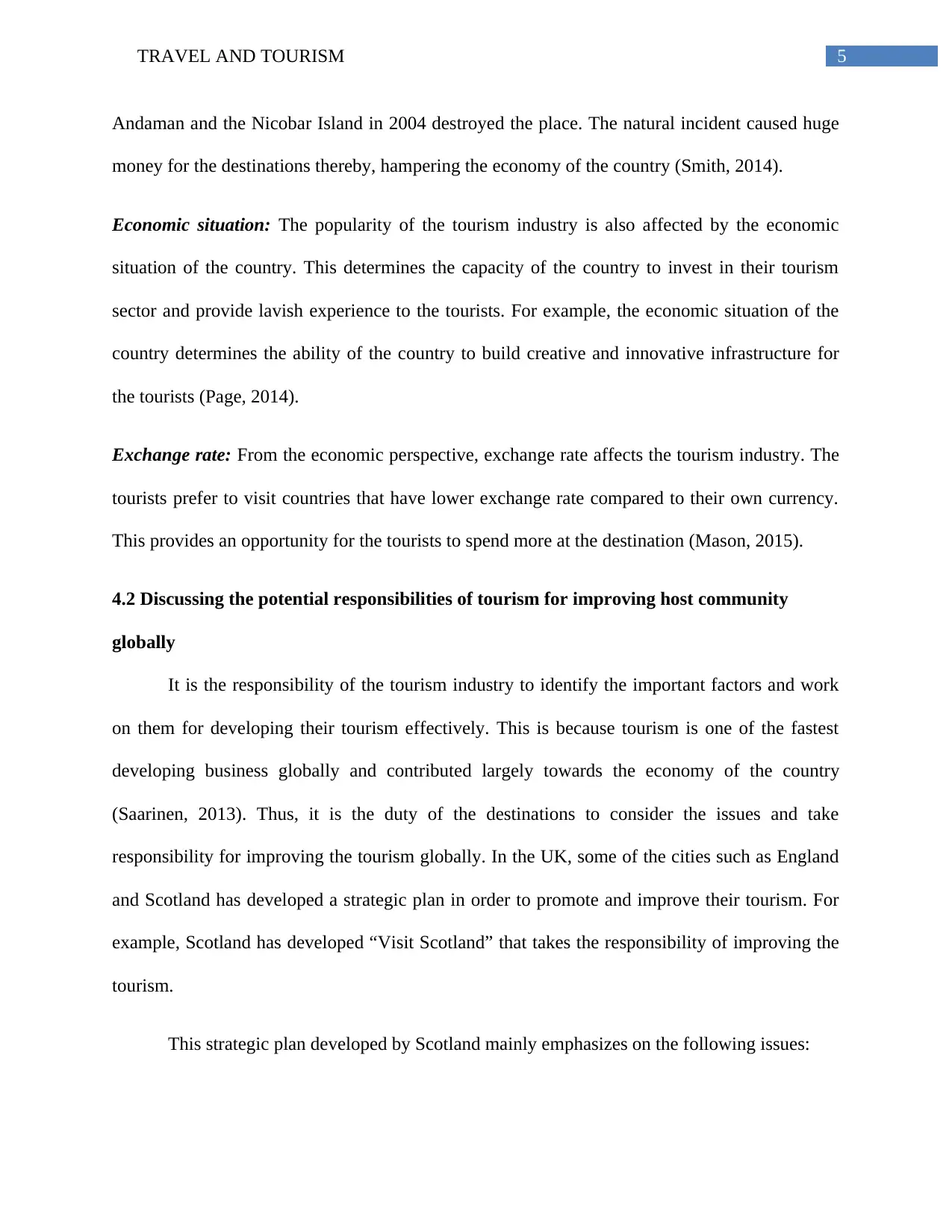
5TRAVEL AND TOURISM
Andaman and the Nicobar Island in 2004 destroyed the place. The natural incident caused huge
money for the destinations thereby, hampering the economy of the country (Smith, 2014).
Economic situation: The popularity of the tourism industry is also affected by the economic
situation of the country. This determines the capacity of the country to invest in their tourism
sector and provide lavish experience to the tourists. For example, the economic situation of the
country determines the ability of the country to build creative and innovative infrastructure for
the tourists (Page, 2014).
Exchange rate: From the economic perspective, exchange rate affects the tourism industry. The
tourists prefer to visit countries that have lower exchange rate compared to their own currency.
This provides an opportunity for the tourists to spend more at the destination (Mason, 2015).
4.2 Discussing the potential responsibilities of tourism for improving host community
globally
It is the responsibility of the tourism industry to identify the important factors and work
on them for developing their tourism effectively. This is because tourism is one of the fastest
developing business globally and contributed largely towards the economy of the country
(Saarinen, 2013). Thus, it is the duty of the destinations to consider the issues and take
responsibility for improving the tourism globally. In the UK, some of the cities such as England
and Scotland has developed a strategic plan in order to promote and improve their tourism. For
example, Scotland has developed “Visit Scotland” that takes the responsibility of improving the
tourism.
This strategic plan developed by Scotland mainly emphasizes on the following issues:
Andaman and the Nicobar Island in 2004 destroyed the place. The natural incident caused huge
money for the destinations thereby, hampering the economy of the country (Smith, 2014).
Economic situation: The popularity of the tourism industry is also affected by the economic
situation of the country. This determines the capacity of the country to invest in their tourism
sector and provide lavish experience to the tourists. For example, the economic situation of the
country determines the ability of the country to build creative and innovative infrastructure for
the tourists (Page, 2014).
Exchange rate: From the economic perspective, exchange rate affects the tourism industry. The
tourists prefer to visit countries that have lower exchange rate compared to their own currency.
This provides an opportunity for the tourists to spend more at the destination (Mason, 2015).
4.2 Discussing the potential responsibilities of tourism for improving host community
globally
It is the responsibility of the tourism industry to identify the important factors and work
on them for developing their tourism effectively. This is because tourism is one of the fastest
developing business globally and contributed largely towards the economy of the country
(Saarinen, 2013). Thus, it is the duty of the destinations to consider the issues and take
responsibility for improving the tourism globally. In the UK, some of the cities such as England
and Scotland has developed a strategic plan in order to promote and improve their tourism. For
example, Scotland has developed “Visit Scotland” that takes the responsibility of improving the
tourism.
This strategic plan developed by Scotland mainly emphasizes on the following issues:
⊘ This is a preview!⊘
Do you want full access?
Subscribe today to unlock all pages.

Trusted by 1+ million students worldwide
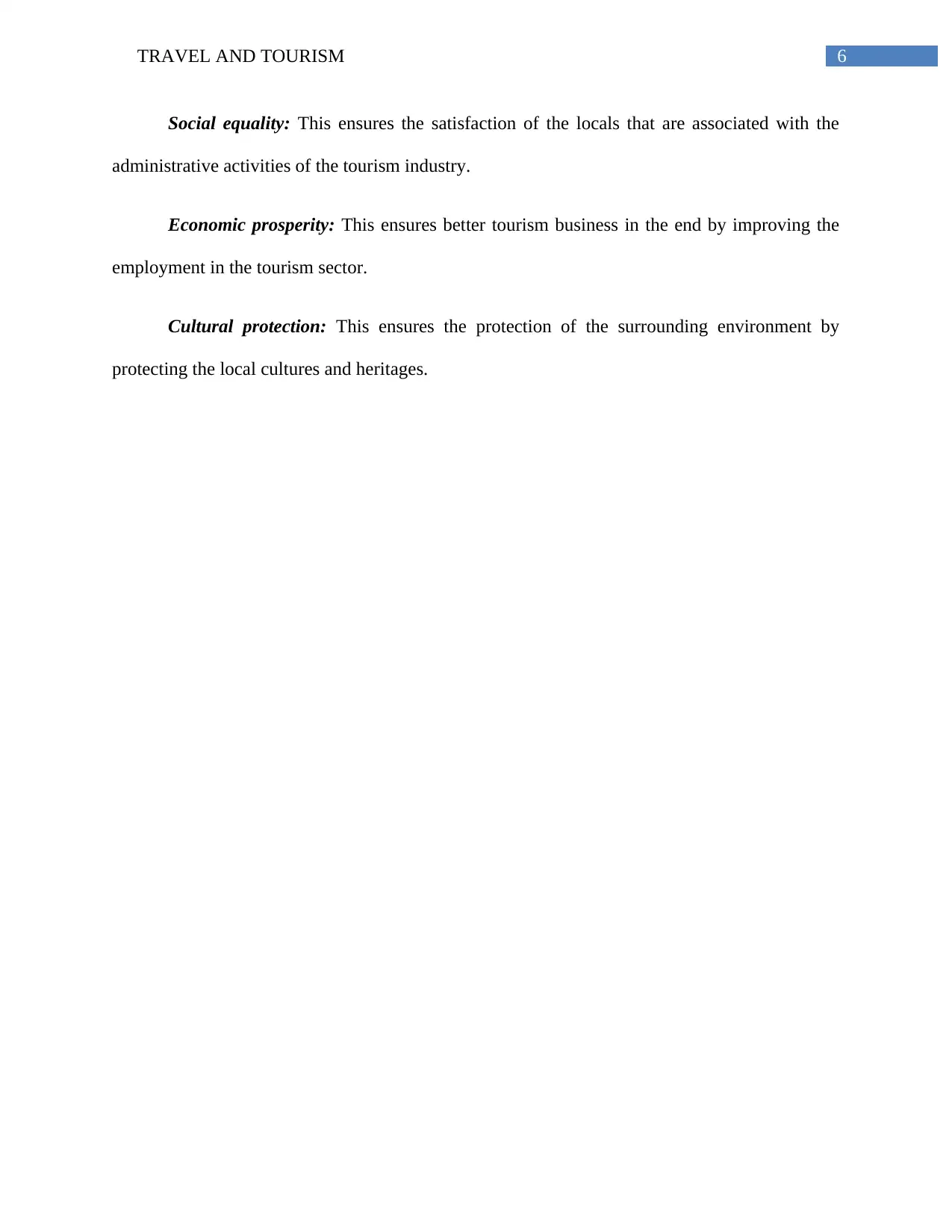
6TRAVEL AND TOURISM
Social equality: This ensures the satisfaction of the locals that are associated with the
administrative activities of the tourism industry.
Economic prosperity: This ensures better tourism business in the end by improving the
employment in the tourism sector.
Cultural protection: This ensures the protection of the surrounding environment by
protecting the local cultures and heritages.
Social equality: This ensures the satisfaction of the locals that are associated with the
administrative activities of the tourism industry.
Economic prosperity: This ensures better tourism business in the end by improving the
employment in the tourism sector.
Cultural protection: This ensures the protection of the surrounding environment by
protecting the local cultures and heritages.
Paraphrase This Document
Need a fresh take? Get an instant paraphrase of this document with our AI Paraphraser
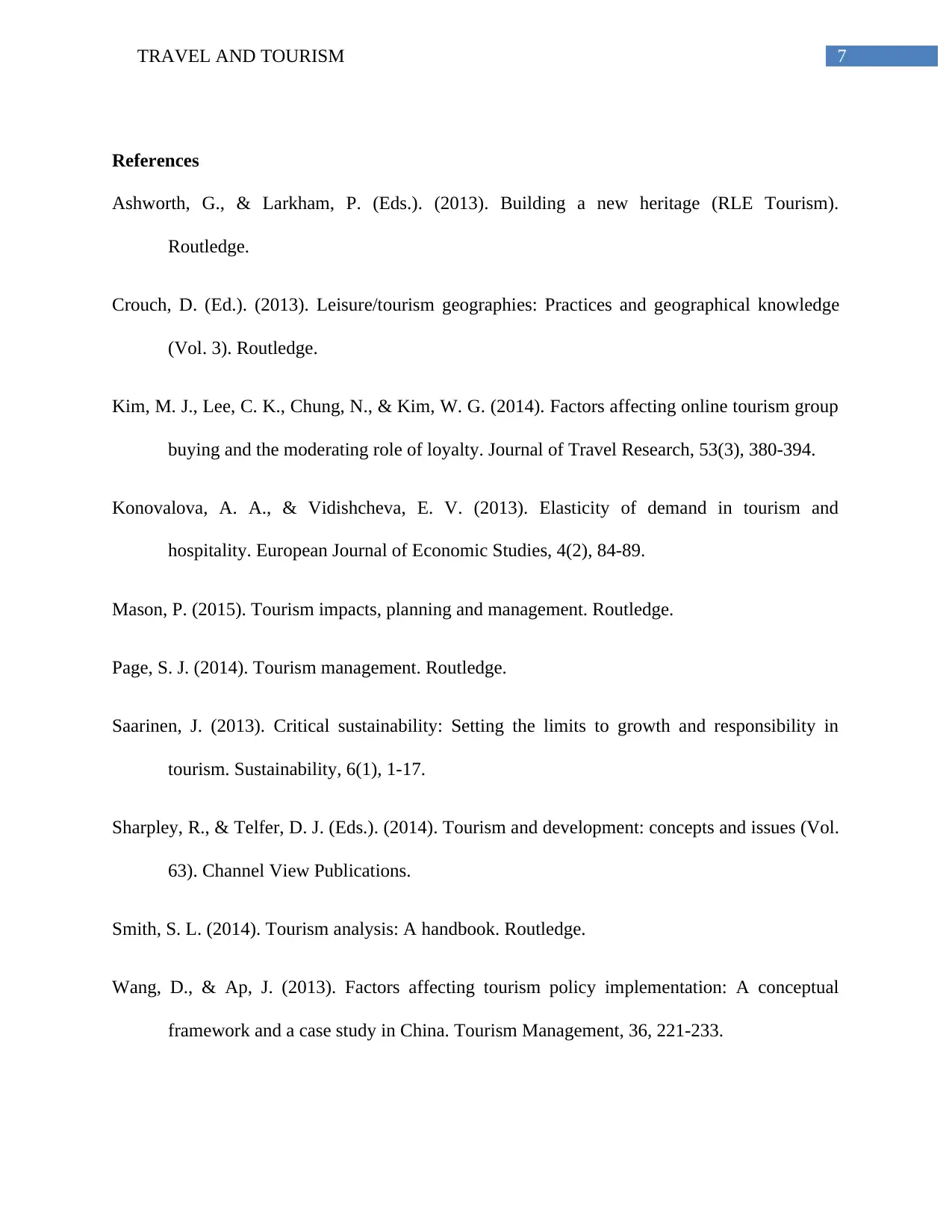
7TRAVEL AND TOURISM
References
Ashworth, G., & Larkham, P. (Eds.). (2013). Building a new heritage (RLE Tourism).
Routledge.
Crouch, D. (Ed.). (2013). Leisure/tourism geographies: Practices and geographical knowledge
(Vol. 3). Routledge.
Kim, M. J., Lee, C. K., Chung, N., & Kim, W. G. (2014). Factors affecting online tourism group
buying and the moderating role of loyalty. Journal of Travel Research, 53(3), 380-394.
Konovalova, A. A., & Vidishcheva, E. V. (2013). Elasticity of demand in tourism and
hospitality. European Journal of Economic Studies, 4(2), 84-89.
Mason, P. (2015). Tourism impacts, planning and management. Routledge.
Page, S. J. (2014). Tourism management. Routledge.
Saarinen, J. (2013). Critical sustainability: Setting the limits to growth and responsibility in
tourism. Sustainability, 6(1), 1-17.
Sharpley, R., & Telfer, D. J. (Eds.). (2014). Tourism and development: concepts and issues (Vol.
63). Channel View Publications.
Smith, S. L. (2014). Tourism analysis: A handbook. Routledge.
Wang, D., & Ap, J. (2013). Factors affecting tourism policy implementation: A conceptual
framework and a case study in China. Tourism Management, 36, 221-233.
References
Ashworth, G., & Larkham, P. (Eds.). (2013). Building a new heritage (RLE Tourism).
Routledge.
Crouch, D. (Ed.). (2013). Leisure/tourism geographies: Practices and geographical knowledge
(Vol. 3). Routledge.
Kim, M. J., Lee, C. K., Chung, N., & Kim, W. G. (2014). Factors affecting online tourism group
buying and the moderating role of loyalty. Journal of Travel Research, 53(3), 380-394.
Konovalova, A. A., & Vidishcheva, E. V. (2013). Elasticity of demand in tourism and
hospitality. European Journal of Economic Studies, 4(2), 84-89.
Mason, P. (2015). Tourism impacts, planning and management. Routledge.
Page, S. J. (2014). Tourism management. Routledge.
Saarinen, J. (2013). Critical sustainability: Setting the limits to growth and responsibility in
tourism. Sustainability, 6(1), 1-17.
Sharpley, R., & Telfer, D. J. (Eds.). (2014). Tourism and development: concepts and issues (Vol.
63). Channel View Publications.
Smith, S. L. (2014). Tourism analysis: A handbook. Routledge.
Wang, D., & Ap, J. (2013). Factors affecting tourism policy implementation: A conceptual
framework and a case study in China. Tourism Management, 36, 221-233.
1 out of 8
Related Documents
Your All-in-One AI-Powered Toolkit for Academic Success.
+13062052269
info@desklib.com
Available 24*7 on WhatsApp / Email
![[object Object]](/_next/static/media/star-bottom.7253800d.svg)
Unlock your academic potential
Copyright © 2020–2025 A2Z Services. All Rights Reserved. Developed and managed by ZUCOL.





